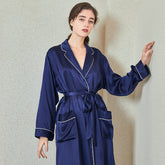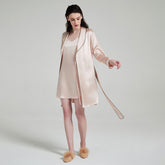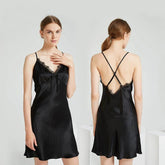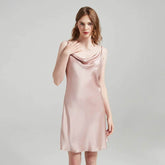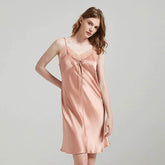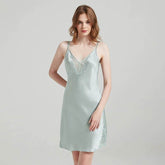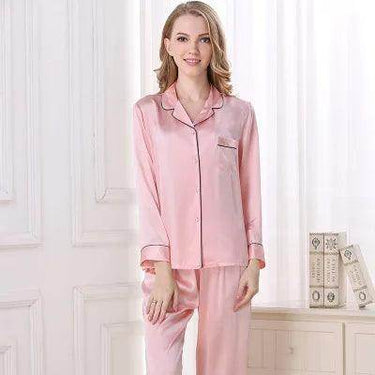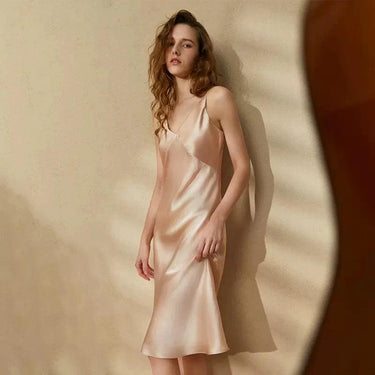Pink Silk Pajamas – Indulge in the Elegance of 100% Mulberry Silk
Understanding Pink Silk Pajamas
The world of luxury sleepwear centers around one exceptional fabric that has endured through centuries: silk. Dating back to ancient China around 6,000 years ago, silk remains the pinnacle of opulent textiles. The journey of silk from imperial Chinese courts to Western wardrobes marks one of the most significant cultural exchanges in fabric history, transforming sleep attire from mere necessity to an expression of refinement.
Pink silk pajamas represent the perfect marriage between function and beauty in luxury sleepwear. The color pink—ranging from delicate blush to rich rose—evokes feelings of warmth, femininity, and tranquility. This shade has transcended fashion trends to become a perennial favorite in silk sleepwear collections. The natural luminosity of silk enhances the pink hue, creating a visual experience that celebrates both the fabric's natural sheen and the color's inherent charm.
Beyond their visual appeal, pink silk pajamas serve as the foundation for restorative sleep. The interaction between genuine mulberry silk and skin creates a microclimate that adapts to your body throughout the night. This fabric responds to your body's temperature fluctuations, cooling when you're warm and insulating when you're cool. The lightweight structure of silk fibers allows for unrestricted movement, letting you shift positions naturally without the fabric restricting or binding.
The appeal of pink silk pajamas extends far beyond aesthetics. While the eye appreciates their lustrous appearance, your skin reaps numerous benefits from direct contact with natural protein fibers. This special relationship between silk and skin has catapulted this luxury from occasional indulgence to essential wellness investment. To understand this transformation fully, we must examine the exceptional quality that makes mulberry silk the uncontested choice for premium sleepwear.

The Exceptional Quality of Mulberry Silk Pajamas
The quality of silk pajamas begins with understanding momme weight—the standard measurement for silk fabric density. This measurement, expressed as the weight in pounds of a piece of silk measuring 45 inches by 100 yards, directly correlates to the fabric's durability and feel. For luxurious silk pajamas, the recommended range falls between 19 to 22 momme. This weight provides the optimal balance between substance and fluidity, ensuring durability without sacrificing the characteristic lightness silk enthusiasts prize.
| Momme Weight | Characteristics | Best Use in Sleepwear |
|---|---|---|
| 13-16mm | Lightweight, semi-transparent | Summer camisoles, shorts |
| 17-19mm | Medium weight, versatile | Year-round pajama sets |
| 19-22mm | Premium weight, substantial | Luxury pajama sets, robes |
| 22mm+ | Heaviest, maximum durability | Investment pieces, heirloom quality |
Silk quality extends beyond weight to its grade classification, which assesses the silk's uniformity, cleanliness, and natural luster. The grading system ranges from A to 6A, with 6A representing the pinnacle of silk quality. Grade 6A silk features consistent thread diameter, minimal impurities, and exceptional natural shine without chemical enhancement. Grade 5A offers excellent quality with minor variations, while 4A—though still superior to many textiles—may contain slight inconsistencies in fiber uniformity.
Authentic mulberry silk possesses unmistakable visual and tactile signatures. The natural protein structure creates a distinctive triangular prism effect with light, producing the characteristic shimmering appearance that changes subtly as the fabric moves. When touched, genuine mulberry silk feels cool initially but quickly warms to body temperature—a sensation synthetic imitations cannot replicate. The fabric drapes with a fluid weight that synthetic alternatives typically fail to achieve.
Mulberry silk stands apart from other varieties like Tussah (wild silk) or Eri silk through its superior uniformity and fineness. While Tussah silk offers rugged durability with its thicker, shorter fibers, it lacks the characteristic smoothness of mulberry silk. Eri silk, though ethically harvested without harming silkworms, produces a more matte appearance and coarser texture compared to the refined elegance of mulberry varieties.
Price differences between silk qualities reflect these distinctions meaningfully. Premium 6A grade, 22 momme mulberry silk pajamas represent significant investments—often priced between $200-500 for a complete set—while lower grade alternatives may cost 30-50% less. This price gap reflects not merely brand positioning but substantial differences in raw material quality, production standards, and expected longevity.
Consumers can verify authentic mulberry silk through several reliable methods. The burn test—where genuine silk smolders rather than melts, producing an odor similar to burning hair—offers one verification approach. The ring test, where genuine silk pulled through a ring retains minimal creasing, provides another confirmation method. Additionally, high-quality silk absorbs water droplets rather than allowing them to bead on the surface, offering a simple authentication test suitable for home use.
The Unparalleled Comfort of Pink Silk Pajamas
The tactile experience of silk against skin creates a sensory pleasure unmatched by other fabrics. The first touch of mulberry silk pajamas introduces a coolness that feels refreshing against warm skin. Within moments, this initial coolness transforms as the natural protein fibers adjust to your body temperature. The smoothness—measuring 1.0-1.5 denier in fiber diameter compared to cotton's 10-15 denier—allows the fabric to glide across skin without catching or creating friction points that disturb sleep.
The temperature-regulating properties of silk derive from its unique molecular structure. Silk fibers contain amino acids arranged in crystalline patterns that create microscopic air pockets. These pockets trap warm air during cool conditions, providing natural insulation. Conversely, in warm environments, silk's natural protein structure wicks moisture away from the body at a rate of 30% humidity absorption without feeling damp. This capacity for moisture management—absorbing up to 30% of its weight in moisture without feeling wet—ensures comfort regardless of ambient temperature.
The protein structure of silk shares remarkable similarities with human hair, containing 18 amino acids that interact harmoniously with human skin. This biological compatibility explains why silk feels like a natural extension of the body rather than an alien material. The lightweight nature of premium silk—approximately 3.5 ounces per square yard—enables unrestricted movement throughout sleep cycles, preventing the sensation of being tangled or constrained that often accompanies heavier fabrics.
Those who transition to silk pajamas frequently describe the experience as "sleeping in a cloud." The fabric moves with the body rather than against it, eliminating the unconscious adjustments sleepers make throughout the night when wearing restrictive fabrics. This freedom from disturbance translates to deeper sleep cycles and fewer nocturnal awakenings, as confirmed by sleep quality studies comparing various sleepwear materials.
Cotton pajamas, though comfortable, absorb moisture from the body and hold it against the skin, creating potential discomfort as temperature changes occur. Polyester, while inexpensive, traps heat and prevents natural temperature regulation. Linen, though excellent for hot weather, typically lacks the year-round adaptability of silk. The universal comfort of silk—functioning effectively across all seasons—places it in a category apart from these alternatives.
Skin and Hair Benefits
The hypoallergenic nature of mulberry silk delivers remarkable benefits for those with sensitive skin. Natural silk fibers contain sericin, a protein that resists dust mites, mold, and many common allergens. Clinical studies demonstrate significantly reduced skin reactivity when subjects with eczema, psoriasis, and contact dermatitis sleep on silk compared to cotton or synthetic materials. The smooth fiber structure minimizes friction against irritated skin, preventing the mechanical aggravation that often exacerbates inflammatory skin conditions.
The reduction of facial sleep wrinkles through silk pajamas has solid scientific foundation. Cotton pillowcases create compression wrinkles through absorption of facial moisture, while silk's smooth surface allows skin to glide without creating tension lines. Dermatological studies demonstrate decreased formation of sleep lines among silk pillowcase users, with similar benefits extending to skin covered by silk pajamas. The reduced friction means less pulling and distortion of facial skin during sleep movements, preserving collagen integrity over time.
Silk maintains optimal skin moisture balance through selective absorption. Unlike cotton, which wicks moisture indiscriminately, silk absorbs only excess moisture while maintaining a hydration balance on the skin surface. This selective action preserves natural facial oils that would otherwise be drawn away by more absorbent materials. Dermatologists note that this moisture retention particularly benefits aging skin, which naturally produces less sebum and requires preservation of existing moisture.
For hair health, silk provides multiple advantages through mechanical protection and moisture preservation. Hair strands, when examined microscopically, show significantly less cuticle damage after contact with silk compared to cotton. The reduced friction prevents the lifting of the hair cuticle—the protective outer layer of each strand—thereby maintaining natural shine and reducing breakage. For those with textured or curly hair, this protection prevents the disruption of curl patterns and reduces the formation of frizz by up to 43% in humidity-controlled studies.
Different skin types derive specialized benefits from contact with silk. Dry skin benefits from silk's moisture retention properties. Oily skin appreciates silk's ability to absorb excess oil without over-drying. Combination skin finds balance through silk's selective absorption. Sensitive skin responds to the reduced mechanical irritation and hypoallergenic properties. These varied benefits explain why dermatologists increasingly recommend silk as part of both preventative and therapeutic skin care regimens.
"The transition to silk pajamas represents one of the simplest yet most effective changes patients can make for skin health," explains Dr. Sarah Reynolds, a board-certified dermatologist specializing in aging skin. "The reduction in mechanical friction alone provides measurable improvements in skin texture and moisture retention, particularly for patients experiencing age-related dryness or increased sensitivity." This professional endorsement reflects growing recognition of silk's role in comprehensive skin health beyond mere luxury.
Popular Pink Silk Pajama Styles
The classic button-up pajama set represents the quintessential silk sleepwear design. Traditional notched collars offer timeless elegance, while mandarin collars provide a contemporary alternative with clean lines. French cuffs with mother-of-pearl buttons add refinement to long-sleeved versions, while short-sleeved variations often feature straight cuffs with subtle piping. The contrast piping—typically in ivory, navy, or black—creates visual definition that highlights the construction quality. Premium sets often include breast pockets with hand-rolled edges, demonstrating meticulous attention to detail characteristic of luxury sleepwear.
Camisole and shorts combinations offer versatility with various strap configurations. Adjustable spaghetti straps provide customizable support, while fixed straps with decorative elements like tiny covered buttons or embroidered details add distinctive character. Hem treatments range from practical elastic to decorative scalloped edges with delicate lace trim. These sets typically feature a relaxed yet flattering fit, with side slits on shorts for ease of movement and gentle elastic waistbands that expand for comfort without compressing the abdomen during sleep.
Silk nightgowns offer elegance in multiple length options. Floor-length designs evoke vintage glamour with sweep measurements of 55-65 inches, allowing dramatic movement. Mid-length options falling just below the knee combine practicality with elegance. Neckline variations include classic V-necks, boat necks for modest coverage, and cowl necks that drape beautifully in silk's fluid weight. Design elements like split sleeves, keyhole openings, and covered button plackets transform functional sleepwear into statement pieces that blur the line between nightwear and loungewear.
Contemporary silk pajama designs incorporate modern aesthetics while honoring the fabric's heritage. Minimalist approaches feature clean lines without embellishment, allowing the fabric's natural properties to become the focal point. Innovative cuts include asymmetrical hems, strategically placed cutouts, and unexpected details like contrasting silk panels or architectural pleating. These modern interpretations maintain silk's functional benefits while introducing fresh visual interest for those seeking alternatives to traditional sleepwear silhouettes.
Different body types benefit from specific style considerations when selecting silk pajamas. Tall figures find comfort in longer inseams and extended torso measurements available from specialty brands. Petite frames benefit from scaled proportions that prevent overwhelming the figure. Fuller figures appreciate designs with thoughtful details like French seams that lie flat against curves and generous cut measurements that ensure the fabric drapes rather than clings. A-line nightgown silhouettes flatter most body types by skimming the torso and flowing gently over the hips.
Occasion-appropriate selections ensure your silk sleepwear meets varied needs. Everyday luxury calls for durable momme weights (19-22) in practical silhouettes that withstand regular laundering. Special occasions merit investment in higher momme weights with decorative details like hand-embroidery or lace insets that might prove impractical for daily wear. Travel considerations include wrinkle-resistance and packability, with folded garments benefiting from tissue paper between layers to prevent permanent creasing during transport.
Caring for Your Pink Silk Pajamas
Hand-washing remains the gold standard for maintaining silk pajamas. Begin with lukewarm water (75-85°F/24-29°C) in a clean basin. Add specialized silk detergent like Tenestar or Soak, using no more than ¼ teaspoon per gallon of water. Conventional detergents—even those marketed for delicates—often contain enzymes and brighteners that break down protein fibers and should be avoided. Submerge garments fully, gently agitating rather than rubbing or twisting. Allow soaking for 3-5 minutes before draining and rinsing thoroughly with cool water until no soap residue remains. Press water out gently between clean towels rather than wringing.
Machine washing, while convenient, requires specific protocols to prevent damage. Select the delicate cycle with cold water and place garments in fine mesh laundry bags to prevent friction against the drum. Load the machine lightly—ideally washing silk items alone—and use the shortest cycle available. Use only detergents specifically formulated for silk, such as Le Blanc Silk & Lingerie Wash or The Laundress Delicate Wash, in half the recommended amount. Skip the spin cycle entirely, or select the lowest spin setting if this option isn't available, as high-speed spinning creates permanent creases.
Proper drying techniques preserve silk's integrity. After washing, roll garments gently in clean, white cotton towels to remove excess moisture without wringing. Lay flat to dry on a fresh towel away from direct sunlight, which can fade colors and weaken fibers. Reshape garments gently while damp, paying special attention to collars, cuffs, and waistbands. Allow 8-12 hours for complete drying, depending on room temperature and humidity. Never use dryers—even on delicate settings—as the heat and tumbling action cause irreversible damage to silk fibers.
Wrinkle removal requires careful approach. Steaming provides the safest method, using a handheld steamer held 6-8 inches from the fabric. Working from top to bottom, allow steam to penetrate the fibers and release wrinkles without direct contact. If ironing proves necessary, use the lowest silk setting (typically 250-275°F/121-135°C) and always place a pressing cloth between the iron and garment. Iron from the inside whenever possible, and never apply pressure over seams or decorative elements, which can create permanent impressions in the fabric.
Stain treatment must address common issues while preserving delicate fibers. For oil-based stains, apply cornstarch or talcum powder immediately to absorb oils before they set, leaving for 6-8 hours before brushing away gently. For water-based stains like wine or juice, blot immediately with a clean, white cloth to absorb liquid without rubbing, then rinse with cold water. Makeup stains respond to gentle application of makeup remover on a cotton swab, working from the outside of the stain inward. Avoid commercial stain removers, which typically contain harsh chemicals that damage silk fibers permanently.
Proper storage prevents yellowing and structural damage. Store clean silk pajamas folded flat with acid-free tissue paper between folds to prevent sharp creases. Choose breathable cotton storage bags rather than plastic, which traps moisture and can promote mildew growth. Cedar blocks or lavender sachets provide natural protection against moths without harsh chemicals that may damage fibers. Rotate stored pajamas periodically, refolding along different lines to prevent permanent creases. Allow ample space between garments to prevent compression damage, particularly for padded or quilted silk items.
Seasonal care adaptations enhance longevity. Summer storage requires additional protection against increased humidity, which can promote mildew. Winter storage benefits from increased protection against dry conditions that may cause static electricity. Air silk pajamas for 24 hours after wearing before returning to storage, allowing natural moisture from body contact to dissipate completely. For extended storage periods, re-fold garments every two months to prevent permanent crease lines.
Professional cleaning becomes necessary when facing stubborn stains, yellowing from age, or when preparing heirloom pieces for long-term storage. Select cleaners specializing in silk or vintage textiles, specifically requesting wet cleaning rather than dry cleaning when possible. Traditional dry cleaning solvents can strip silk's natural proteins, causing gradual deterioration of the fabric's characteristic properties. Established specialists like Jeeves of Belgravia or RAVE FabriCARE maintain expertise in handling luxury textiles and represent worthwhile investments for maintaining valuable silk pieces.
Seasonal Versatility of Pink Silk Pajamas
Summer showcases silk's natural cooling properties through moisture management. The protein structure wicks perspiration away from the body at a molecular level, creating a microclimate that feels 3-5°F cooler than the ambient temperature. Lightweight options (13-16 momme) maximize this cooling effect, with short-sleeved or sleeveless designs allowing additional heat dissipation. The natural temperature regulation prevents the clammy sensation often experienced with synthetic fabrics, making silk exceptional for hot, humid climates where both heat and moisture challenge comfort.
Winter reveals silk's surprising insulation capabilities. The same protein structure that cools in summer creates thermal barriers in cooler weather. The amino acid chains trap body heat close to the skin while still allowing perspiration to escape, preventing the chilling effect that occurs when moisture remains against the body. For maximum winter comfort, select higher momme weights (19-22) which provide additional substance without bulk. Layering becomes more effective with silk as the foundation layer due to its minimal thickness, allowing for normal movement even with additional garments.
Transitional seasons benefit from silk's adaptability. Spring weather fluctuations—where evenings remain cool while days warm quickly—showcase silk's responsive temperature regulation. Fall weather patterns, with gradually decreasing temperatures, demonstrate silk's effectiveness in maintaining comfort through changing conditions. This adaptability eliminates the need for seasonal wardrobe transitions, as the same silk pajamas perform effectively year-round with minor adjustments to layering or weight selection.
Travel across climate zones particularly benefits from silk's versatility. A single set of silk pajamas functions effectively from tropical locations to mountain retreats without requiring multiple sleepwear options. The material's natural wrinkle recovery makes it practical for packing, while its lightweight nature conserves luggage space and weight. The hypoallergenic properties prove especially valuable when encountering unfamiliar environments where new detergents or materials might trigger sensitivities.
Seasonal style adaptations enhance silk's functional benefits. Summer pink silk pajamas in lighter rose or blush tones reflect light and create visual coolness. Winter options in deeper berry or mauve shades provide psychological warmth through color psychology. Spring selections featuring botanical prints celebrate seasonal renewal, while fall choices in richer pink tones complement the seasonal palette. These chromatic adjustments complement silk's physical properties while enhancing seasonal enjoyment.
Fabric weight considerations should follow practical guidelines for optimal comfort. Weights between 13-16 momme suit warmer environments with temperatures above 75°F (24°C). Mid-range weights between 17-19 momme provide ideal versatility for temperature ranges between 55-75°F (13-24°C). Heavier weights between 19-22 momme offer maximum comfort in cooler environments below 55°F (13°C). This graduating scale ensures appropriate selection based on both personal preference and environmental conditions.
Investment Value of Quality Pink Silk Pajamas
Cost-per-wear analysis reveals the economic logic behind investing in premium silk pajamas. A high-quality 22 momme silk pajama set priced at $300 may seem expensive initially, but practical calculation demonstrates its value. With proper care, such a garment typically maintains its quality for approximately 5-7 years of regular use. Assuming tri-weekly wear (156 uses annually), the cost per wearing calculates to approximately $0.38 over a five-year period. This compares favorably to lower-quality alternatives costing $75 but requiring replacement after 12-18 months, resulting in a similar per-wear cost but with inferior comfort and aesthetics.
Durability comparisons between fabrics reveal silk's surprising strength. Despite its delicate appearance, silk fibers demonstrate tensile strength comparable to steel wire of the same diameter. Practical durability tests show silk withstanding 2-3 times more tension than cotton before fiber damage occurs. Under normal wear conditions, premium silk pajamas typically maintain structural integrity for 5-7 years with proper care, while cotton equivalents commonly show significant wear after 2-3 years. Polyester alternatives, while initially durable, often develop pilling and lose their aesthetic appeal within 18-24 months.
Long-term value considerations extend beyond mere durability to include the enduring appeal of classic silk designs. Unlike trend-driven sleepwear that appears dated within seasons, traditional silk pajama silhouettes maintain relevance for decades. This timeless quality allows investment pieces to transcend fashion cycles, providing continued satisfaction where trendy alternatives quickly become obsolete. The psychological value of owning investment-quality garments—the pleasure derived from items that maintain their beauty through years of use—adds intangible but meaningful value to the ownership experience.
Maintenance costs warrant consideration in comprehensive value assessment. While silk requires specialized care products, these expenses prove minimal when amortized across the garment's lifespan. A 16-ounce bottle of silk-specific detergent costing $20 typically provides sufficient cleaning for up to 80 wash cycles, equating to approximately $0.25 per cleaning. This modest maintenance cost helps preserve the initial investment while extending usable lifespan significantly compared to improper care methods that accelerate deterioration.
The quality-versus-quantity perspective illustrates why discerning consumers increasingly select fewer, finer items rather than numerous lower-quality alternatives. The ownership experience differs fundamentally—one silk pajama set offering years of exceptional comfort compared to multiple replacements of lesser quality items that never provide equivalent satisfaction. This philosophy extends beyond economic considerations to encompass the environmental impact of reduced consumption and the psychological benefits of surroundings oneself with fewer but more meaningful possessions.
Long-term silk owners consistently report satisfaction that transcends initial cost concerns. "After fifteen years, my silk pajamas have developed a softness and character that only improve with time," reports Rebecca Lawson, who purchased her first silk set in 2007. "The cost seemed significant initially, but dividing that amount across fifteen years of nightly comfort reveals it as one of my wisest purchases." This testimonial represents common sentiment among those who select quality over quantity in personal items that impact daily comfort and wellbeing.
Top Brands for Pink Silk Pajamas
Luxury options in pink silk pajamas begin with established heritage brands. La Perla stands as the pinnacle of luxury sleepwear, with signature details including hand-finished seams, exceptional drape from 22+ momme silk, and subtle brand elements like mother-of-pearl buttons engraved with the brand's logo. Their price points reflect this craftsmanship, typically ranging from $600-1,200 for complete sets. Their pink palette focuses on sophisticated blush tones and muted rose hues that complement their minimalist aesthetic. Eberjey offers luxury with approachable elegance, featuring 19-22 momme silk with distinctive piping details and feminine silhouettes. Their price points range from $350-600, with signature pink tones focusing on warm peach-pinks and classic rose colorways.
Mid-range quality brands provide excellent value while maintaining high standards. LilySilk represents this category effectively, offering 19 momme silk with precise stitching and thoughtful details like reinforced stress points. Their pricing ranges from $200-400 for complete sets, with their pink palette including both vibrant fuchsia and subtle powder pink options. Their value proposition centers on certified non-toxic dyes and traceable silk sources. Lunya takes a modern approach with innovative cuts and multifunctional designs crafted from 19 momme washable silk. Their $180-350 price range reflects their contemporary approach, with signature terracotta pinks and muted mauve tones distinguishing their aesthetic. Their quality indicators include French seams and heat-set labels that eliminate irritation.
Budget-friendly alternatives provide genuine silk options at accessible price points. Quince offers remarkable value through their direct-to-consumer model, providing 19 momme mulberry silk pajamas at $80-150. Their streamlined designs eliminate costly details while maintaining fundamental quality through French seams and bound edges. Their pink palette focuses on universally flattering blush tones. Etam balances affordability with quality through strategic material allocation, using 16-17 momme silk for primary panels with stretch silk blends for cuffs and waistbands, creating $100-200 sets with enhanced comfort and durability. Their pink options typically include brighter rose tones and occasionally patterned designs.
Distinctive features separate these brands beyond price considerations. La Perla's silk possesses a distinctive weight and drape achieved through proprietary finishing techniques, creating an immediately recognizable hand-feel. LilySilk utilizes a charmeuse weave that maximizes luster on the exterior while maintaining a matte interior for comfort. Lunya's washable silk undergoes a specialized sandwashing process that creates a distinctive texture while enhancing durability. Quince focuses on practical benefits with reinforced stress points at seams and closures. These technical distinctions create meaningful differences in the wearing experience beyond aesthetic considerations.
Price comparisons reveal interesting patterns across brands. Entry-level luxury pieces from La Perla often exceed the cost of premium offerings from mid-range brands like LilySilk by 200-300%. However, mid-range options typically provide 80-90% of the quality experience at significantly reduced cost. Budget-friendly alternatives deliver approximately 70-75% of the luxury experience at 25-30% of the premium price point. This diminishing return curve explains why mid-range options often represent the optimal balance between quality and value for discerning consumers seeking meaningful quality without maximum expense.
Sizing considerations vary significantly between brands, necessitating careful selection. European luxury brands like La Perla typically run smaller than American size standards, often requiring selection 1-2 sizes larger than usual. Asian brands like LilySilk similarly run 1-2 sizes smaller than American standards. Most brands provide detailed measurement charts rather than relying solely on standard sizing designations. Sleeve lengths, inseams, and torso measurements warrant particular attention when selecting across brands, as proportional scaling differs significantly between manufacturers targeting different demographic markets.
Availability and shipping information impact purchasing decisions meaningfully. La Perla maintains limited retail distribution through luxury department stores and branded boutiques, with online purchasing available worldwide but often incurring significant import duties for international customers. Mid-range brands typically operate primarily through direct online sales with more limited retail presence. Budget-friendly options like Quince operate exclusively online with longer delivery timelines reflecting their made-to-order business model. These availability differences impact both immediate gratification and the ability to evaluate garments physically before purchase.
The Psychology of Wearing Pink Silk
Research into luxury sleepwear reveals fascinating correlations with sleep quality metrics. A 2022 sleep laboratory study conducted at the University of Milan found that participants wearing silk pajamas experienced 7% longer REM sleep duration compared to control groups in cotton sleepwear. Subjects also reported falling asleep an average of 8 minutes faster when wearing silk pajamas compared to synthetic alternatives. While these studies cannot isolate whether physical comfort or psychological factors drove these improvements, the consistent correlation suggests meaningful connection between premium sleepwear and measurable sleep benefits.
The psychological aspects of self-care through premium sleepwear extend beyond mere vanity. Establishing deliberate nighttime rituals—including changing into dedicated sleepwear—creates powerful psychological triggers that prepare the mind for rest. Neuropsychological research demonstrates that consistent pre-sleep rituals increase melatonin production and decrease cortisol levels, creating physiological conditions conducive to quality sleep. When these rituals incorporate sensory pleasure through luxurious fabrics, the psychological benefits amplify through positive association and anticipated comfort.
Color psychology research specifically addresses pink's impact on human psychology. Studies at the University of Iowa documented decreased aggressive behavior in environments featuring certain pink tones (specifically Baker-Miller pink), while broader color psychology research identifies pink as producing feelings of nurturing, compassion, and calm. These qualities make pink particularly suitable for sleepwear intended to promote relaxation. The specific wavelengths of light reflected by pink tones interact with visual receptors to create measurable relaxation responses in brain activity studies measuring alpha wave patterns associated with relaxed alertness.
The connection between feeling good and sleeping well represents bidirectional causality confirmed through extensive research. While conventional wisdom recognizes that quality sleep improves mood, emerging research increasingly identifies how positive pre-sleep emotions enhance sleep quality. Functional MRI studies demonstrate that positive emotional states before sleep correlate with more efficient transitions between sleep phases and fewer nocturnal awakenings. This research explains why investing in sleepwear that creates positive associations and physical comfort yields dividends beyond the merely aesthetic or sensory.
Psychological benefits of sleep rituals find strong support in clinical literature. "The transition from day to night represents a critical psychological boundary," explains Dr. Michael Breus, clinical psychologist specializing in sleep disorders. "Dedicated sleepwear creates a clear delineation between daytime responsibilities and nighttime restoration. When this sleepwear provides exceptional comfort and aesthetic pleasure, it strengthens the psychological boundary between these states and enhances the mind's readiness for restorative sleep." This professional perspective reinforces the value of quality sleepwear beyond mere indulgence.
Supplemental Content: Beyond the Basics
Are pink silk pajamas suitable for all skin types?
Pink silk pajamas prove universally compatible with all skin types due to their hypoallergenic protein structure. Even individuals with diagnosed skin conditions like eczema, psoriasis, or contact dermatitis typically tolerate silk exceptionally well. The absence of synthetic dyes in naturally-colored silk eliminates a primary allergen source, while the protein structure of silk itself contains sericin—a natural compound with antimicrobial properties that prevents irritation from bacterial growth. Those with extreme sensitivity should select undyed "white" silk that undergoes minimal processing, then test with a small fabric swatch against the inner wrist for 24 hours before committing to full garments. For most individuals, including those with sensitive skin, silk represents one of the most biocompatible textile options available.
How does the momme weight affect the feel and durability of pink silk pajamas?
Momme weight fundamentally determines both the tactile experience and longevity of silk pajamas through fiber density. Lower momme weights (13-16mm) create an ethereal, gossamer feel with exceptional drape but reduced durability—typically lasting 2-3 years with regular use. Mid-range weights (17-19mm) balance sensory pleasure with practical durability, providing a substantial hand-feel while maintaining fluid movement and typically lasting 3-5 years. Premium weights (19-22mm) offer maximum durability with a more substantial presence against the skin, often maintaining quality for 5-7 years or longer. This weight influences not only longevity but also temperature regulation capacity, with heavier weights providing enhanced insulation while lighter weights maximize cooling properties. The selection between these weights represents a fundamental decision affecting both immediate sensory experience and long-term satisfaction.
What are the key differences between washable silk and traditional silk pajamas?
Washable silk undergoes specific processing that fundamentally alters its interaction with water molecules. Traditional silk contains protein structures that can distort when saturated with water, particularly during agitation. Washable silk undergoes a specialized process called sandwashing, which slightly roughens the fiber surface and often includes silicon-based treatments that enhance water resistance. These modifications produce several concrete differences: washable silk typically feels slightly less lustrous but softer to touch; it demonstrates 30-40% greater colorfastness during washing; it dries approximately 25% faster than traditional silk; and it generally exhibits enhanced durability through repeated laundering. The trade-off for this convenience includes a subtle reduction in the fabric's natural sheen and slightly diminished temperature-regulating properties. For practical daily use, washable silk offers meaningful advantages despite these modest compromises in traditional silk's distinctive characteristics.
Should you choose different silk weights for different seasons?
Seasonal adaptation through silk weight selection optimizes comfort throughout the year. For summer conditions, lightweight silk (13-16mm) maximizes cooling properties while still providing necessary coverage. This weight allows maximum air circulation and moisture evaporation, making it ideal for environments above 75°F (24°C). For transitional seasons with moderate temperatures, mid-weight silk (17-19mm) provides versatile performance, balancing insulation with breathability. This middle range proves most versatile for temperatures between 55-75°F (13-24°C). For winter conditions, heavyweight silk (19-22mm) offers enhanced insulation while maintaining breathability, ideally suited for environments below 55°F (13°C). While silk's natural temperature regulation allows single-weight garments to function adequately year-round, this graduated approach optimizes comfort across extreme seasonal variations. Those in relatively stable climates may find a single mid-weight option (17-19mm) provides the optimal balance for year-round use.
These technical considerations reveal the complexity beneath silk's seemingly simple elegance. Understanding these factors enables informed selection based on individual priorities rather than price alone. While luxury pricing often correlates with quality, knowledgeable consumers can identify exceptional value through understanding these fundamental characteristics rather than relying solely on brand positioning or marketing claims. This knowledge transforms silk pajama selection from mere preference to informed investment in nightly comfort and wellbeing.
Gift-Giving Guide: Pink Silk Pajamas
Specific occasions naturally lend themselves to the gift of silk sleepwear. Wedding preparations create perfect opportunities, with bridal silk pajamas serving both practical function during wedding morning preparations and creating memorable photography moments. Milestone anniversaries—particularly traditional silk anniversaries at 12 years—pair symbolically with silk gifts. Significant birthdays marking life transitions benefit from gifts that combine luxury with daily utility. These milestone occasions justify higher investment in premium options from luxury brands like La Perla or Eberjey, while mid-range options from LilySilk or Lunya suit more regular gift-giving occasions.
Size selection presents unique challenges when gifting silk pajamas. Rather than guessing exact measurements, utilize the recipient's existing clothing as reference. Standard sizing varies significantly between brands, with European and Asian manufacturers typically sizing smaller than American counterparts. When uncertainty exists, selecting slightly larger sizes proves wiser than smaller, as generous silk drapes flatteringly while tight silk creates uncomfortable restriction. Many premium retailers offer exchange policies specifically addressing gift sizing concerns, though this requires verification before purchase.
Personalization elevates silk pajamas from generous gift to cherished keepsake. Monogramming options include traditional initials in complementary thread colors, typically positioned discreetly on cuffs or pockets. Hand-embroidered dates commemorate specific occasions, while custom packaging—such as handcrafted wooden boxes or personalized garment bags—enhances the presentation experience. These personalization services typically require 7-14 additional business days and increase costs by 15-30%, but create distinctive gifts impossible to duplicate commercially.
Gift presentation significantly impacts recipient experience. Traditional gift boxes lined with acid-free tissue preserve silk's quality while creating dramatic unveiling moments. Complementary items that enhance the silk experience—such as silk pillowcases, sleep masks, or lavender sachets—create comprehensive sleep sanctuary gifts. Wooden hangers wrapped in complementary silk provide both practical storage and aesthetic continuity. These thoughtful presentation elements transform functional gifts into sensory experiences that begin from the moment of unwrapping.
Return policy considerations require particular attention when gifting silk pajamas. Premium retailers typically offer extended return windows for gifts, often 60-90 days compared to standard 30-day policies. Exchange-only policies prove common with personalized items, while some luxury retailers offer "perfect fit guarantees" with complimentary alterations. Understanding these policies before purchase prevents potential disappointment, particularly when sizing concerns exist. For international gifting, verify whether return shipping costs receive coverage or remain the recipient's responsibility.
Price point guidance helps navigate appropriate investment based on relationship. Close family relationships (parents, siblings, children) and romantic partnerships justify higher investments in the $200-500 range for premium silk pajamas. Extended family and close friendships align appropriately with mid-range options between $100-250. Professional relationships benefit from thoughtfully selected accessories like silk sleep masks rather than intimate apparel, regardless of price point. These guidelines help navigate the complex intersection between generosity and appropriateness in gift selection.
Personal touches transform silk pajamas from commercial products to meaningful gifts. Handwritten notes explaining the benefits of silk demonstrate thoughtful research beyond mere expenditure. Knowledge of personal preferences—such as preferred sleeve lengths or temperature sensitivities—demonstrates attentive relationship investment. References to shared experiences or inside jokes through color selection or styling create emotional resonance beyond the gift itself. These personalized elements often create more lasting impression than price point alone, making even modest silk gifts memorable through thoughtful presentation.
The Environmental Impact of Silk Production
Traditional silk farming methods involve centuries-old practices with significant environmental implications. The cultivation of mulberry trees—the sole food source for Bombyx mori silkworms—typically occurs without chemical pesticides, as these compounds harm the silkworms themselves. This results in mulberry farming producing 60% fewer soil contaminants than conventional cotton cultivation. The silk extraction process, however, involves boiling silk cocoons with the pupae inside, raising ethical concerns despite its relatively low environmental impact. Water usage represents the most significant environmental concern, with traditional silk production requiring approximately 1,500 gallons per pound of finished silk—less than cotton's 1,800 gallons but substantially more than synthetic alternatives.
Sustainable silk production alternatives address these concerns through modified practices. Organic silk production eliminates all chemical inputs throughout the production chain, from mulberry cultivation through processing and dyeing. Recycled water systems in modern facilities reduce freshwater consumption by 60-70% compared to traditional methods. These sustainable approaches typically increase production costs by 15-30%, explaining their limited adoption despite growing consumer interest in environmentally responsible textile options.
Peace silk (also called Ahimsa silk) provides an ethical alternative by allowing silk moths to emerge naturally before processing empty cocoons. This approach maintains the renewable aspects of silk production while eliminating harm to the silkworms themselves. The resulting silk features a slightly textured appearance compared to traditional silk's smooth surface, as the moth's emergence breaks the continuous filament. This production method remains relatively rare, comprising less than 5% of global silk production. Brands specializing in peace silk include Cocccon and Ahimsa Silk, with wider availability through specialty retailers focusing on ethical textiles.
Carbon footprint comparison reveals silk's complex environmental position. The production of one pound of silk generates approximately 35 pounds of carbon dioxide equivalent, compared to polyester's 16 pounds. However, silk's exceptional longevity—typically 5-7 years compared to synthetic alternatives' 1-2 years—creates a more favorable lifetime environmental assessment. Additionally, silk's biodegradability allows complete decomposition within 1-5 years in composting conditions, while polyester requires 500+ years to break down in landfills.
Longevity represents a critical environmental factor often overlooked in sustainability discussions. High-quality silk garments typically remain in active use 3-5 times longer than trend-driven fast fashion alternatives. This extended useful life distributes the initial environmental impact across significantly more uses, reducing the per-wear environmental cost. The timeless aesthetic of traditional silk designs further extends useful life by transcending fashion cycles that render trend-focused items obsolete despite their physical integrity.
Environmental certifications provide guidance for conscientious consumers. The Global Organic Textile Standard (GOTS) certifies organic cultivation practices throughout production. OEKO-TEX Standard 100 certification ensures textile products remain free from harmful substances. Bluesign certification addresses comprehensive environmental management throughout production. These certifications allow consumers to verify environmental claims beyond marketing language, though they typically correlate with price premiums reflecting the additional oversight and sustainable practices they guarantee.
Balancing luxury with environmental responsibility requires nuanced understanding rather than absolute positions. Silk represents neither the most nor least environmentally intensive textile option but offers exceptional longevity that improves its lifetime environmental profile. Conscientious consumers can mitigate environmental impact by selecting high-quality, timeless designs that remain in active use for many years; purchasing from manufacturers using certified sustainable practices; and providing proper care to maximize useful life. These practices transform silk from mere indulgence to environmentally defensible investment in lasting quality.
From Luxury to Necessity: Why Pink Silk Pajamas Are Worth the Investment
The journey through the world of pink silk pajamas reveals a consistent theme: what initially appears as luxury increasingly emerges as practical investment in physical and psychological wellbeing. The temperature-regulating properties that adapt to both seasonal variations and nightly fluctuations create unmatched sleep comfort. The hypoallergenic nature of silk fibers provides reliable relief for sensitive skin conditions. The gentle interaction between silk and hair prevents damage and maintains styles overnight. These functional benefits transform silk from occasional indulgence to daily necessity for those prioritizing sleep quality and personal care.
From a personal wellness perspective, quality sleep attire represents a fundamental component of comprehensive self-care. While considerable attention focuses on mattress quality, room temperature, and electronic use, sleepwear remains frequently overlooked despite its constant skin contact throughout the night. The investment in mattresses costing thousands of dollars logically extends to appropriate sleepwear that enhances this investment's benefits. The direct correlation between sleep quality and overall health—including immune function, cognitive performance, and emotional regulation—positions quality sleep as necessity rather than luxury, with appropriate sleepwear forming an essential component of this foundation.
Creating a complete sleep sanctuary requires attention to all elements that impact rest quality. Premium mattresses provide structural support, high-thread-count sheets create comfortable foundations, and quality pillows deliver proper alignment. Pink silk pajamas complete this ecosystem through moisture management, temperature regulation, and friction reduction. This comprehensive approach recognizes that sleep quality depends not on isolated premium elements but on the harmonious interaction between all components of the sleep environment. The relatively modest investment in silk pajamas compared to other sleep environment elements makes them particularly accessible entry points into sleep quality improvement.
The timeless nature of pink silk establishes its position as investment rather than expenditure. While fashion trends cycle rapidly, both the material and color have maintained consistent popularity for centuries. This enduring appeal ensures that quality pink silk pajamas purchase today will remain aesthetically relevant for their entire functional lifespan—typically 5-7 years with proper care. This transcendence of fashion cycles contrasts sharply with trend-driven sleepwear that often becomes visually dated within seasons despite maintained functionality, creating both aesthetic and practical obsolescence that necessitates replacement.
The elegance and indulgence that first attract consumers to pink silk pajamas ultimately represent only their most superficial benefits. Beneath these immediately apparent qualities lies remarkable functionality derived from silk's unique protein structure and interaction with human physiology. This marriage between beauty and function creates uncommon value that justifies the initial investment many times over through years of enhanced sleep quality, skin health benefits, and simple pleasure in something both beautiful and useful. The value proposition extends beyond economic calculation to encompass the intangible but significant benefits of surrounding oneself with objects that provide both pleasure and purpose.
The ultimate value of pink silk pajamas lies in their transformation of necessary daily activities into experiences of comfort and beauty. Sleep represents approximately one-third of human lifespan—a proportion too significant to experience in uncomfortable or inadequate attire. The modest premium required for quality silk pajamas, when distributed across years of nightly use, represents minimal investment in maximizing both comfort and benefit from these essential hours. This perspective reframes luxury not as extravagance but as intelligence—the recognition that activities comprising significant portions of our lives warrant thoughtful investment in optimal experience.
For those considering entering the world of silk sleepwear, the invitation remains simple: experience directly what centuries of human history have confirmed. The unique properties of premium mulberry silk, the distinctive comfort of pajamas cut and constructed to maximize these properties, and the specific benefits of pink tones for relaxation and rest quality combine to create sleep attire that transcends ordinary expectations. This experience transforms understanding from academic appreciation to embodied knowledge, revealing why generations of discerning individuals have selected silk not merely as luxury but as necessity for optimal rest and restoration.
LANI SILK offers premium 100% mulberry silk pajamas that embody all the exceptional qualities discussed throughout this article. Crafted with meticulous attention to detail, their pink silk collection delivers the perfect balance of elegance and functionality. Experience the transformative benefits of genuine mulberry silk with their expertly crafted sleepwear, designed to enhance both your sleep quality and personal wellness routine. Visit their website to explore their collection of investment-worthy silk pajamas that combine luxurious comfort with practical benefits for skin, hair, and sleep.


